Displaying items by tag: eastern hellbender
Meet the candidate: Eastern hellbenders finally in line for inclusion on Endangered Species List
 The U.S. Fish and Wildlife Service seeks public comment on a proposal to place the eastern hellbender on the Endangered Species List. The hellbender seen here is part of an exhibit at an East Tennessee zoo. Chattanooga Zoo
The U.S. Fish and Wildlife Service seeks public comment on a proposal to place the eastern hellbender on the Endangered Species List. The hellbender seen here is part of an exhibit at an East Tennessee zoo. Chattanooga Zoo
USFWS seeks public comment on proposed listing of crucial indicator species throughout its known range; several populations in Smokies region
Melissa Clark is a U.S. Fish and Wildlife Service senior public affairs specialist.
The U.S. Fish and Wildlife Service announced Dec. 12 a proposal to list the eastern hellbender as an endangered species throughout its range under the Endangered Species Act. Eastern hellbenders are found in Alabama, Georgia, Illinois, Indiana, Kentucky, Maryland, Mississippi, Missouri, New York, North Carolina, Ohio, Pennsylvania, Tennessee, Virginia and West Virginia.
“The eastern hellbender is a unique salamander that plays a crucial role in maintaining healthy freshwater ecosystems,” said Service Midwest Regional Director Will Meeks. “As key indicators of stream and river health, hellbenders need protection that also will help support healthier ecosystems across their range.”
Historically, eastern hellbenders have been documented in 626 populations. Recent data indicate only 371 of these populations (59%) remain. Among the remaining populations, only 45 (12%) are stable, 108 (29%) have an unknown recruitment status, and 218 (59%) are in decline.
The eastern hellbender is one of two subspecies of hellbenders in the United States. The other subspecies, the Ozark hellbender, occurs in Missouri and Arkansas and was listed as an endangered species in 2011. In 2021, the Missouri distinct population segment of the eastern hellbender was listed as endangered.
Ela dam removal proceeds to make a river run through
 Ela Dam on the Oconaluftee River in Cherokee. The dam is slated for removal to benefit aquatic species and the Eastern Band of the Cherokee Indians. Erin McCombs
Ela Dam on the Oconaluftee River in Cherokee. The dam is slated for removal to benefit aquatic species and the Eastern Band of the Cherokee Indians. Erin McCombs
Ela Dam Removal Coalition moving forward after $4 million grant from U.S. Fish and Wildlife to commence river restoration project
Erin McCombs is the Southeast Conservation Director of American Rivers.
CHEROKEE — American Rivers is working with a team on a massive effort to remove the Ela dam and restore the land and Oconaluftee River to its natural condition. Partnering with the Eastern Band of Cherokee Indians (EBCI), American Rivers is part of a coalition of federal, state, public, private, and non-profit organizations that has formed to remove the Ela dam.
Truly a village effort, the Ela Dam Coalition includes the EBCI, American Rivers, Mainspring Conservation Trust, the North Carolina Wildlife Resources Commission, the U.S. Fish and Wildlife Service, the Southern Environmental Law Center, the Environmental Protection Agency, American Whitewater, Swain County, the Army Corps of Engineers, and Northbrook Carolina Hydro II.
“Healthy rivers are essential to all life, and removing a dam is the fastest way to restore a river’s health. We appreciate this initial investment by U.S. Fish and Wildlife Service in the restoration of the Oconaluftee River. We look forward to working with them to leverage this investment to fully realize this project to revitalize fish and wildlife habitat and restore vital cultural connections. We are grateful to the Eastern Band of Cherokee Indians for their leadership, and for the partnership of Mainspring Conservation Trust,” said Tom Kiernan, American Rivers President and CEO.
Blocking the Oconaluftee River’s natural flow impacts the aquatic habitats of many native fish, mussels, birds, and other wildlife which require it for sheltering, feeding, reproducing, and thriving in their natural environment. The removal of Ela dam will result in a cultural reconnection of the Oconaluftee River to the Cherokee people and the Qualla Boundary.
The Oconaluftee River is home to 11 sensitive and rare aquatic species, some of which are only found in a few streams and rivers in western North Carolina, including the federally endangered Appalachian elktoe freshwater mussel, the Sicklefin Redhorse (NC Threatened), and Eastern Hellbender (NC Special Concern). Once complete, 549 miles of the Oconaluftee River watershed will be restored and expand habitat for these species.
- american rivers
- ela dam
- eastern band of cherokee indians
- ela dam coalition
- mainspring conservation trust
- north carolina wildlife resources commission
- us fish and wildlife service
- southern environmental law center
- oconaluftee river
- joey owle
- environmental protection agency
- american whitewater
- swain county
- army corps of engineers
- northbrook carolina hydro ii
- bryson city
- sicklefin redhorse
- eastern hellbender
- appalachian elktoe